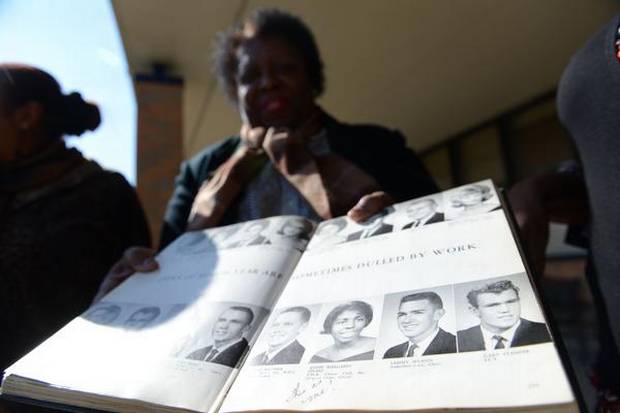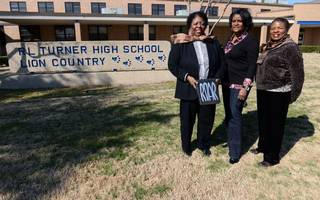|

R. L. Turner School alumna Annie Spears Edwards opens the page
to her photo in her high school
yearbook outside the school on Feb. 12, 2014 in Carrollton.
Edwards attended the school
they year it was integrated in 1963. (Rose Baca/Neighborsgo
Staff Photographer.
When Annie Spears Edwards arrived at R. L. Turner High
School in September 1963, the incoming senior was terrified, she
said.
"During my childhood I have seen the [Ku Klux Klan], and I was
really frightened because I knew what was happening in
Mississippi, Alabama and I just knew we were going to be
bombed," said the 68-year-old Lancaster resident.
Like many African-American students in Carrollton during
the 1960's, Edwards attended multiple high schools including
Booker T. Washington in Dallas and Fred Moore High School in
Denton. During that era, the former Carrollton High School and
Turner, which opened in 1962, were segregated schools.
That division changed in 1963 when Annie Heads Rainwater
filed a lawsuit against the school district and won, said Angela
Shelley, director of Strategic Communication Services for
Carrollton-Farmers Branch ISD. Integration went into
effect during the 1963-64 academic year, Shelley said.
Today, the school district consists of 39 schools, five of
which are high schools, and 26,000 students.
On Saturday, the Carrollton Black History Program will be
held at 3 p.m. in the Turner auditorium. The event, which is
hosted by Christ Community Connection Inc., will include
speeches, information on integration as well as community
leaders such as Mry Heads Carter and Jimmy Porter, said group
founder the Rev. Willie Rainwater.
CHANGING SCHOOLS
Dorothy Graves first arrived at Turner in 1963 as a
junior. The former Turner student said she was "scared to death"
to attend the newly integrated school.
That was something very new, and all the things that were
going around the country at the same time, it was very scary,"
Graves said..
The now 66-year-old Lewisville resident encountered
several new experiences, including entering Turner for the first
time in her academic career and interacting with students of a
different race.
"I had never been around that many white people in my
life, because the only time that I would be around white people
[is] when we went to the school and that was it," she said.
Edwards and Graves are both daughters of Otis Spears, who
was an active participant in the lawsuit against the school
district, and is also the namesake of Otis Spears Elementary
School in Frisco ISD.
"The day that we went there, the school district, they
tried to protect us from the cameras, you know, from people ...
tried to hurry up and get us inside the school, I guess so we
wouldn't be attacked by the reporters or anyone else," Graves
said of her initial experience at Turner.
Despite the tumultuous, political and social events around
the country during the 1960's, Graves said she personally never
experienced incidents while at Turner.
"You would hear things in the hallway, you know how kids
are, but as far as being verbally attacked or physically
attacked, I didn't see anything like that," she said.
Nancy Williams, 67, daughter of Annie Heads Rainwater,
said Booker T. Washington students who lived in Carrollton would
initially take the Carrollton bus, which would drop them off at
Keller Springs Road and Marsh Lane.
"Carrollton bus put us out up there to catch the Dallas
bus, and there was no shelter at all, no shelter," she said.
"Then the Carrollton bus couldn't wait with us, because they had
to take the elementary kids back to school, so whatever the
weather was, that's just what we had to deal with."
She also noted that some of the Dallas buses didn't have
heat or would break down occasionally.
Williams said during the first days of her academic career
at Turner, the students were "overly helpful and friendly," but
by the second semester, everyone was beginning to relax around
each other.
Edwards was particularly fond of her assistant principal,
W. B. "Sky" Green.
"Every time I saw him, he had a smile and he made me feel
welcome and safe," she said.
THROUGH THE DECADES
Williams and Edwards experienced differing effects of
segregation in the community. Both women remembered a local
hamburger restaurant that served African-American customers in
the back and white customers in the front. The former
Plaza Theater, they said, seated black patrons upstairs in the
balcony area and white moviegoers on the bottom or the second
leve.
Williams said Carrollton's progress seemed to follow in
the district's footsteps.
"Actually I noticed, if you stopped to think about it,
once the school was integrated, the town just automatically
integrated," Williams said. "All of the sudden, you know,
places you didn't go in, they could go. It was just once it was
done, it was just done, for the most part."
Though Graves and Williams no longer live in Carrollton,
member of their famileis attend public school in the city.
Williams' granddaughter, Rhythm Butler, attends Annie
Heads Rainwater Elementary. Graves' daughter, Eva Graves,
graduated from Newman Smith High School in 1983, while her son,
Emagii Graves, graduated from Turner in 1990.
Graves has also been a member of the Christ Community
Connection Inc. for at least 10 years and said she plans to
participate in the black history program at Turner this year.
"It brings back a lot of memories," Graves said of
participating in the prgram at her former school. "You see
on the news when they talk about people, how the schools were
integrated, just to even think that I was part of something like
that, is amazing."
|
![]() Carrollton-Farmers
Branch TXGenWeb
Carrollton-Farmers
Branch TXGenWeb